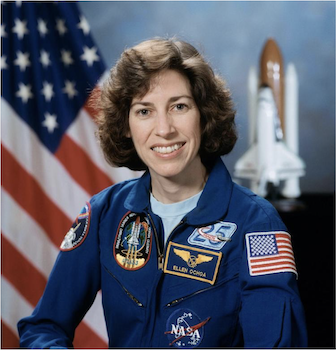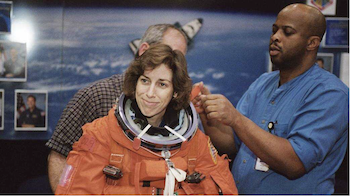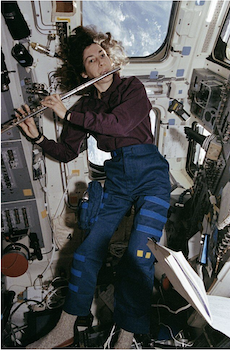
Ellen Ochoa was born on May 10, 1958, in Los Angeles, California. Ochoa had three brothers, Tony, Wilson, and Monte, plus one sister, Cindi. Her father, Joseph Ochoa, grew up in America and experienced discrimination for being a first-generation Mexican-American. As a result, the shame he felt about his heritage as a result of judgment restrained him from teaching his children how to speak Spanish. Throughout her childhood, Ochoa's parents always stressed the importance of education and encouraged her to pursue it. Her mother finished college around the time Ochoa was born. However, Ochoa’s parents would end up divorcing by the time she was in middle school. During this transition in her life, Ochoa coped with the situation by focusing on her flute performance and excelling in school, particularly in math and science.
In 1978, Ochoa graduated from Grossmont High School in La Mesa, California. She was the valedictorian in her graduating class and was offered a full-ride scholarship from Stanford University. However, she turned down this offer and decided to stay local by attending San Diego State University instead. There, she received a bachelor of science in physics and was valedictorian of her college graduating class. Ochoa wanted to major in engineering, however, due to the lack of female engineers and apparent gender disparities , she was discouraged from entering the field. At this point, Ochoa didn’t know what career she wanted, but she knew she wanted to continue learning. Therefore, she applied to Stanford to get her master’s in science and doctorate degrees in electrical engineering in 1981 and 1985.

During her time at Stanford, Ochoa was one of the only women in her program. There, she helped create a patent for optics, the study of how light behaves. Ochoa worked on creating optical systems that gather and analyze information about the objects being seen. In addition, during her time at Stanford, Sally Ride became the first American female astronaut. Accordingly, this inspired Ochoa and some of her classmates to pursue becoming an astronaut themselves, leading her to apply for the National Aeronautics and Space Administration (NASA) Astronaut Training Program in 1985. Though she was rejected, she didn’t give up on her ambition to become an astronaut. Instead, she focused on furthering her work in optics at the Sandia National Library in New Mexico where she was developing computer optical systems for space travel. Ochoa applied again for NASA in 1987 and was turned down once more.
Despite repeatedly facing rejection from NASA, Ochoa never let this adversity stop her from persevering until her dreams were fulfilled. Ochoa got a new job at the Ames Research Center in California. Amnes worked closely with NASA which helped Ochoa step towards her goal. During her time there, Ochoa met her husband, Coe Miles, whom she married in 1990 and had two sons with. After a few months at Amnes, Ochoa received a promotion to Chief of the Division of Intelligent Systems Technology where she oversaw a team of 35 scientists. In 1990, Ochoa applied to NASA again and was accepted into their astronaut training program at the Johnson Space Center.

In 1991, Ochoa passed her training and officially became an astronaut. Her first space mission was in 1993 where she spent nine days aboard the Space Shuttle Discovery. Her mission was to study the effects of solar activity on the environment of the Earth. She went on her second mission to space in 1994 for eight days to study the damage to the ozone layer. In 1999, she went to space for the third time making history once again by making the first docking of a spacecraft on the International Space Station. Along with her scientific endeavors away from Earth, Ochoa played the flute, becoming the first astronaut to play an instrument in space. Her last mission to space took place in 2002. She logged over 978 hours in space across her four missions. After her missions, Ochoa still worked for NASA and gained various leadership positions. Specifically, she became Deputy Director of the Johnson Space Center in 2007 and served as the Director of the Johnson Space Center from 2013 to 2018.
Currently, Ochoa is retired but spends her time advocating and engaging with students to promote interest in STEM. For example, she served on the National Science Board from 2020-2022 and still engages with NASA. In 2017, she was inducted into the United States Astronaut Hall of Fame. Ochoa has six schools across the nation named after her: Ellen Ochoa STEM Academy, Ellen Ochoa Middle School, Ellen Ochoa Prep Academy, Animo Ellen Ochoa Charter Middle School, and Ellen Ochoa Learning Center. In addition, in 2015, NASA awarded Ochoa the Distinguished Service Medal which is their highest award. Ochoa hopes that her story inspires students, especially Hispanic students to pursue their dreams, even if they at first feel out of reach.
Why Did I Choose to Research Ellen Ochoa?
I chose to research Ellen Ochoa because I wanted to learn about Hispanic astronauts. I had come across a biography of her on NASA’s website and there I learned she was the first female Hispanic astronaut in the entire world. This inspired me to learn more about her life and career. After researching her, I want her story to be told more as she is an inspirational figure for people all over the world to look up to. She demonstrates how rejection isn’t the end and preserving will allow for anyone to triumph.
Works Cited
Aliano, Kelly. “Life Story: Ellen Ochoa.” Women & the American Story, 13 Mar. 2024, http://wams.nyhistory.org/end-of-the-twentieth-century/the-information-age/ellen-ochoa/ Accessed 30 Mar. 2024.
“Ellen Ochoa.” Lemelson, https://lemelson.mit.edu/resources/ellen-ochoa Accessed 30 Mar. 2024.
“NASA Astronaut Dr. Ellen Ochoa.” NASA, NASA, https://www.nasa.gov/people/nasa-astronaut-dr-ellen-ochoa/ Accessed 30 Mar. 2024.
Ramirez, Sonia. “Celebrating Ellen Ochoa: The First Latina in Space & NASA Trailblazer.” Latina, 11 Apr. 2023, http://latina.com/celebrate-ellen-ochoa-the-first-latina-in-space-nasa-trailblazer/ Accessed 30 Mar. 2024.
This article was published on 6/10/24